As before, Intel’s new line of mobile processors comes in four flavors: HX, H, P, and U, ordered from high to low by power and performance goals, which, of course, will vary by implementation. The new Intel Core mobile lineup spans the spectrum from thin and light laptops to large, rugged desktop-replacement gaming laptops.
Meet the Intel 13th Gen Core Mobile Series

First, let’s look at the processor itself. The big news here is of course the new HX series processors. Intel says its 13th Gen Core HX platform is “built for enthusiasts and professionals,” and we can certainly understand why. The company didn’t explicitly confirm this, but like the 12th-gen Core HX processors, the high-end Raptor Lake CPUs are apparently built on essentially the same silicon as the faster 13th-gen desktop processors.
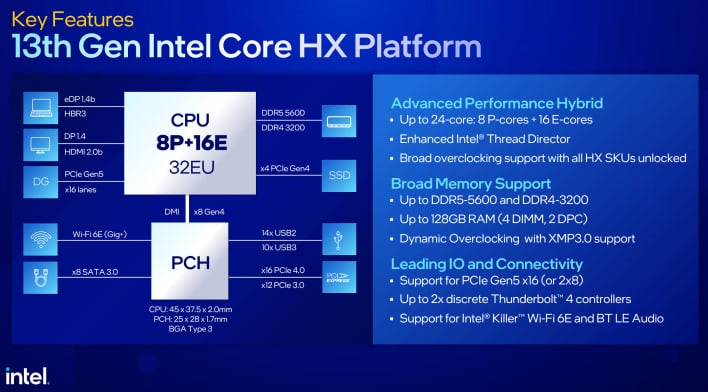
That means, at the absolute high end, you get 8 Raptor Cove performance cores, 16 Gracemont efficiency cores, and a clock rate of up to 5.6 GHz on the flagship Core i9-13980HX. Like desktop chips, these processors require a discrete PCH (or “chipset”), and since they’re aimed at being paired with a discrete GPU, they come with relatively modest 32-EU integrated graphics.
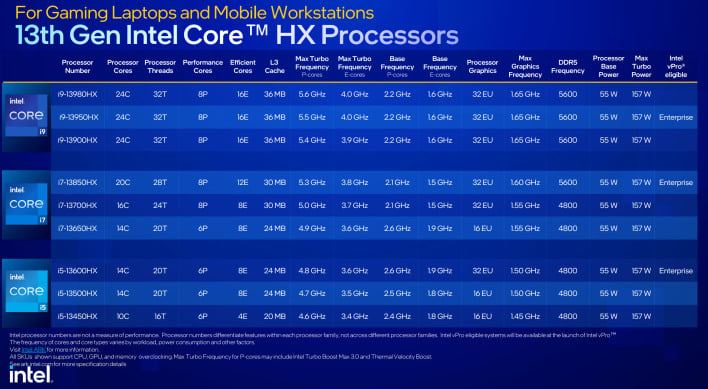
Interestingly, some models of the new generation actually have slightly lower base clocks, and may stay within the same 55W power budget as the previous generation despite the presence of the extra CPU cores. However, the boost clock is increased by 600 MHz, as is the memory clock, and the high-end SKU supports fast DDR5-5600 RAM. Additionally, each model comes fully unlocked for overclocking — another change from Intel’s previous generation, where the vPro-enabled chips locked the core clocks.

Meanwhile, Intel’s 13th generation Core Mobile U, P, and H processors use two different chips: one with six Golden Cove P cores and eight Gracemont E cores, and another with two of the same P cores and the same Eight E cores. If these configurations sound familiar, that’s because they’re essentially (but not literally) newer Alder Lake mobile processors. We say “basically” because they’re not just reheated leftovers; Intel did some work to update the recipe.
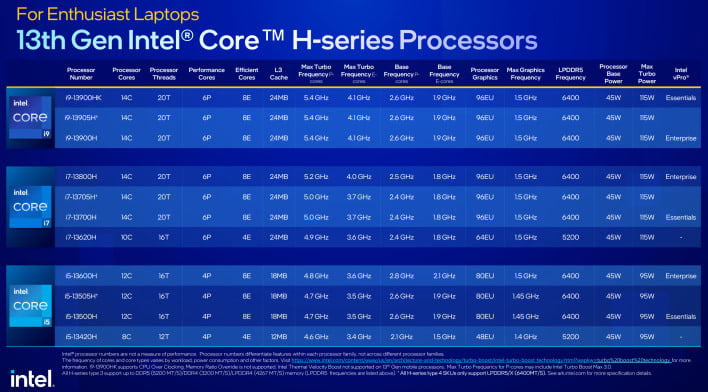
The most notable change in the H-series processors is the overall upward shift in clock speed, typically to around 300 to 400 MHz on the CPU cores and 50-100 MHz on the GPU. As before, these processors have more powerful integrated graphics than the HX-series processors, since they’re less likely to be paired with a discrete GPU; the 96-EU Iris Xe you’ll find on most models has more horsepower.
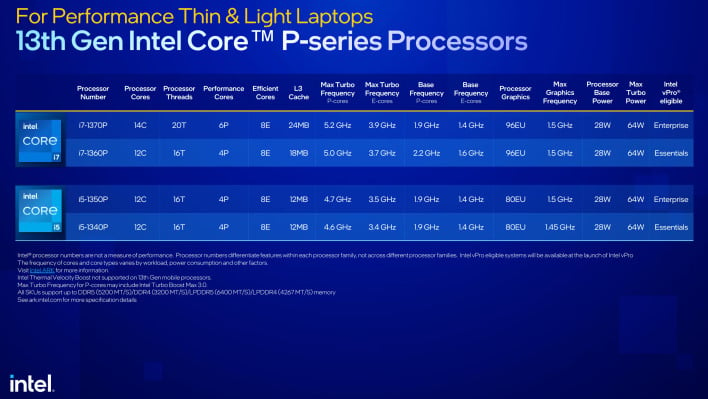
Lowering the stack in terms of power constraints, we have the Core P series. The concept of the series – focusing on mid-power options between a 15W ULV processor and a 45W or 55W high-end processor – isn’t entirely new, but it was formalized in the previous generation of the lineup. The latest iteration of the Core P-series sees an update very similar to that of the aforementioned H-series.
That means basically the same CPU, but with a little polish to keep it shiny. The previous generation Core i7-1280P has been moved down to the Core i7-1370P, although it gets a turbo frequency of 300-400 MHz and a base and graphics frequency of 100 MHz. The previous 1270P was bumped out to become the Core i7-1360P, and it got the same upgrade. The Core i5-P model, meanwhile, is largely unchanged aside from the extra clock speed, and the Core i3-1220P is gone entirely.
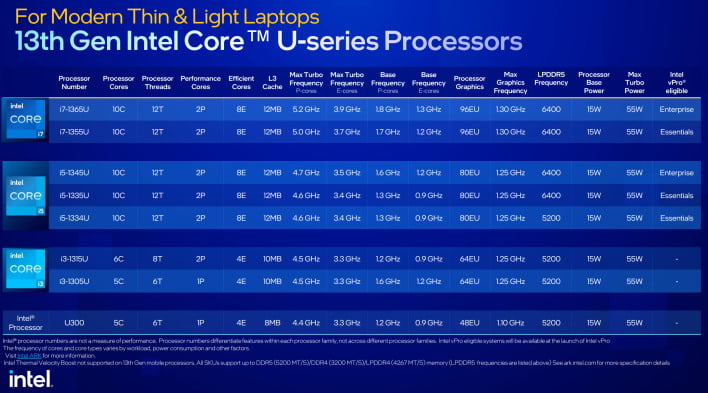
For the smallest 13th Gen CPUs, we’re looking at nine processors, only eight of which carry the “Core” branding. Two Core i7, three Core i5 and two Core i3, all based on the 2P+8e chiplet. All Core i7s and all Core i5s keep all ten cores, while the Core i3-1315U cuts the E cores in half, and then the Core i3-1305U loses one more P core. The Core i3 SKU also lacks more graphics, down to 64 EUs.
As expected, all of these chips are clocked higher than the previous-generation chip, likely due to process improvements — even just 100 MHz higher in the case of the Core i3. Core i5s get 200 or 300 MHz, while higher-end models get a maximum turbo frequency of up to 400 MHz, peaking at 5.2 GHz. However, it’s unlikely the processor will maintain that frequency for long at its 55W maximum turbo power.
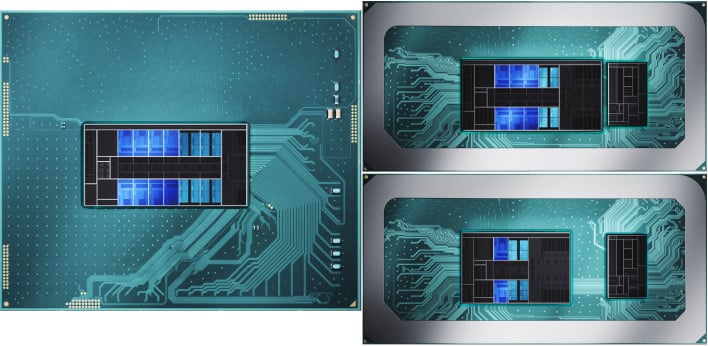
Intel has retired the Pentium and Celeron brands since the release of the previous generation of Core mobile chips, so the stripped-down Raptor Lake mobile version is called the “Intel Processor U300.” It’s closely related to last year’s Pentium 8505, with the same parts in the same configuration, right down to the clock speed. Thankfully, Intel won’t be launching a CPU without Turbo Boost this time around.
Details of Intel’s 13th Gen Core Mobile Performance Claims
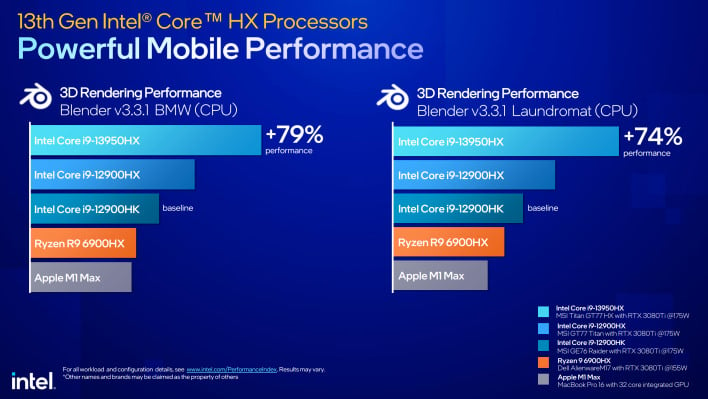
Naturally, Intel has some slides promising strong performance improvements, mostly in productivity apps. In the case of the Raptor Lake HX processors, that’s thanks in large part to the eight extra E-cores, which pack a solid multi-core punch, as in these Blender benchmarks, where the Core i9-13950HX outperforms its The previous generation improved by almost 80% equal.
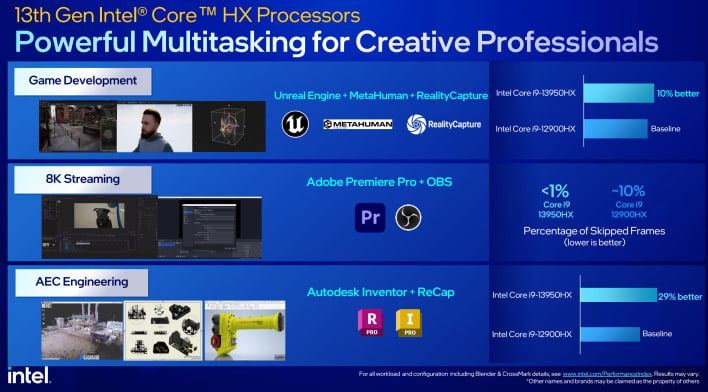
The benefits of the Autodesk and Adobe suites are more limited, but still understandable. These are the types of tasks we generally recommend users perform on a desktop, however, this is essentially a desktop processor, so if your laptop is properly cooled (and plugged in), the Core i9-13950HX can handle these tasks.
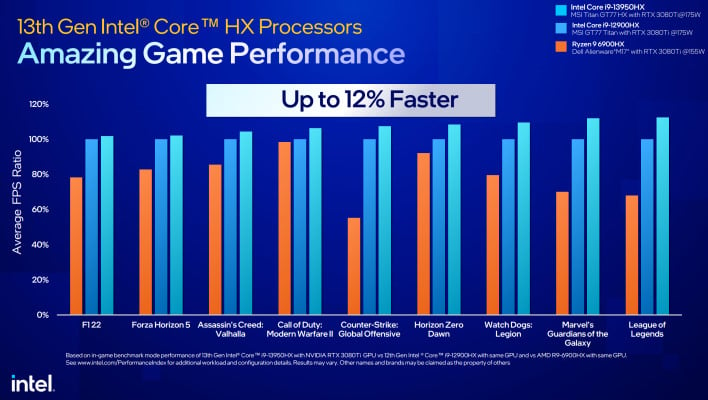
Additional L2 cache and boost to turbo clock also benefit the system’s gaming performance. The gains aren’t as big as desktop Raptor Lake, but those chips also can’t hit the ceiling with unlimited power.
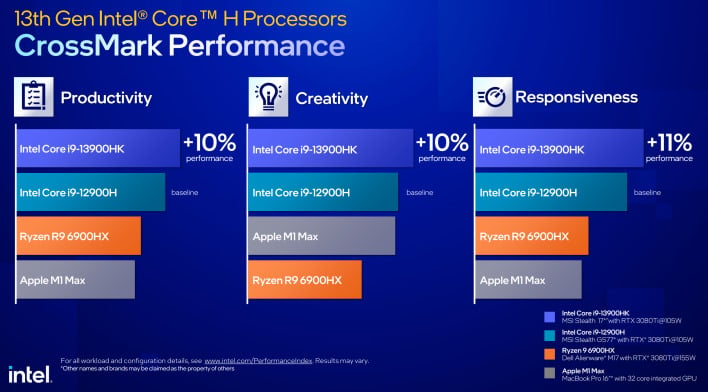
Intel is also touting some performance gains from the 12th Gen Core “H” series processors, though it’s really just a benchmark. This page compares the Core i9-13900HK with the Core i9-12900H as well as two competitors from rival companies, and it outperforms its own predecessor by 10-11% in the three BAPCo CrossMark categories.
Intel Evo laptop development continues
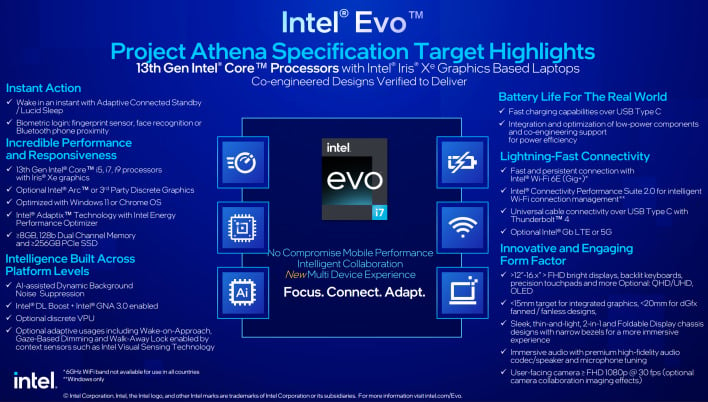
Eventually, Intel’s Project Athena evolved into what the company calls “Evo.” This is essentially a platform marketing initiative, not unlike the company’s “Ultrabook” or “Centrino” initiatives of the past few years. The Intel Evo Notebook PC incorporates a number of specific features and functions in order for the Evo Notebook PC to provide a baseline set of functionality, performance, and user experience. The graph above gives an accurate overview of where these features stand as of now, and Intel says it has more than 15 OEMs working on more than 100 Evo designs.
In addition to Evo platform systems, Intel says it has “more than 60” designs based on desktop-class Core HX processors, and “more than 250” designs featuring 13th-generation H-, P-, and U-series CPUs. Look for laptop designs based on the new 13th Gen Core CPUs coming this quarter.